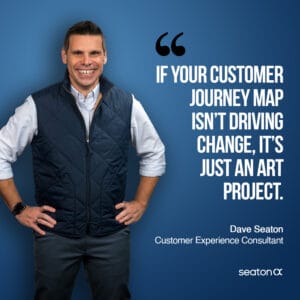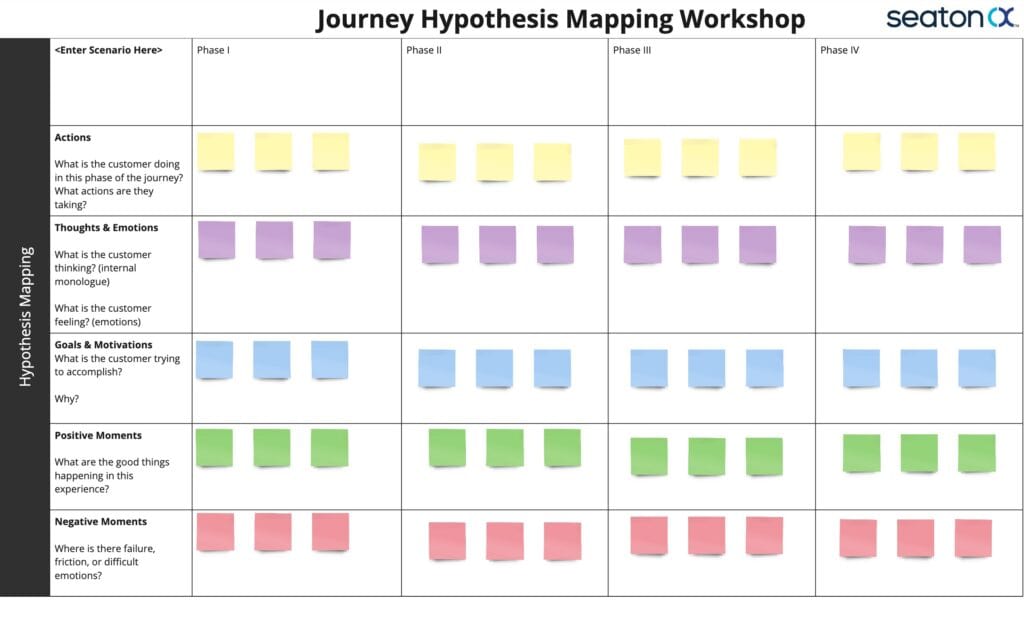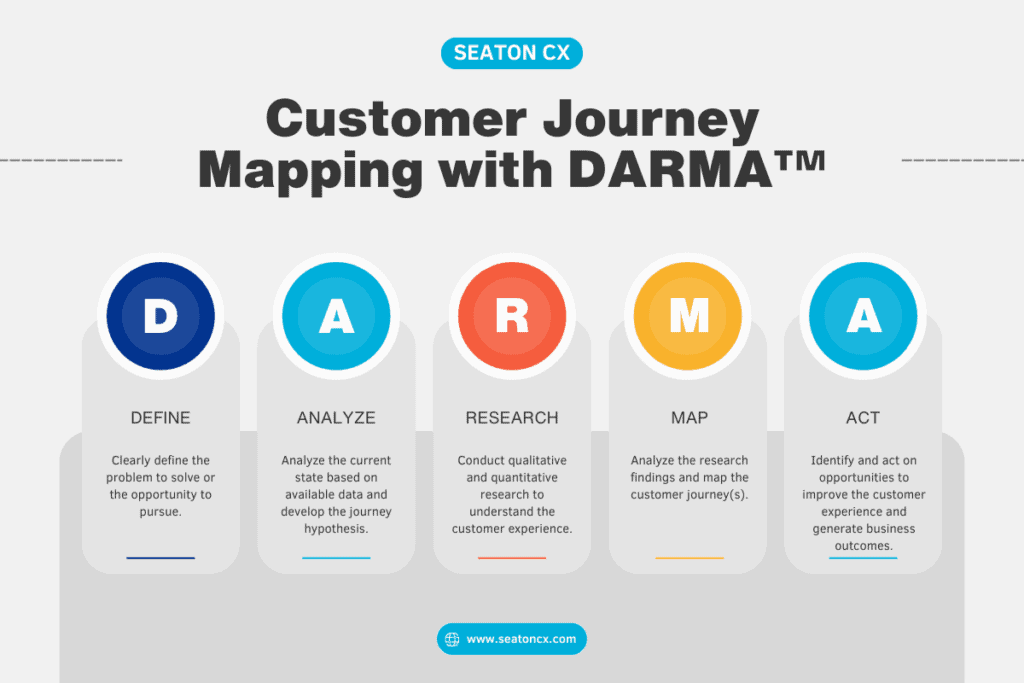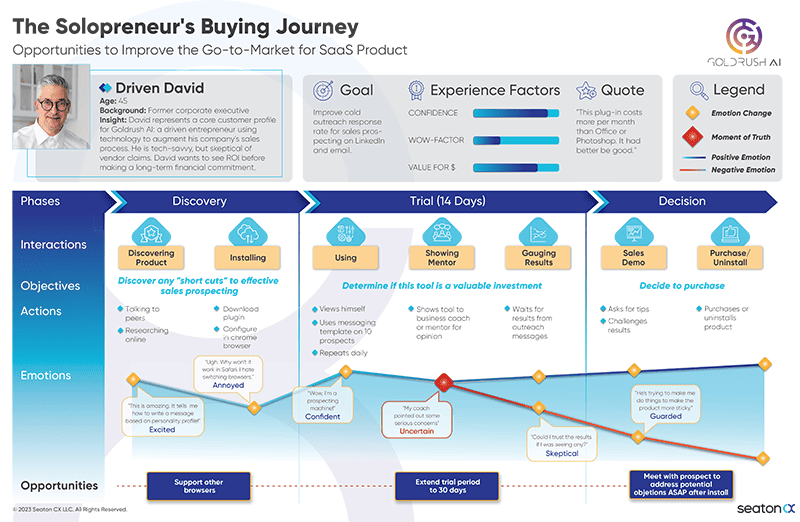Customer journey mapping is the foundation of customer experience management.
A customer journey map informs your customer experience (CX) strategy, identifies where to listen for customer feedback, and connects your CX vision to the design, delivery, measurement, and management of the customer experience.
Journey maps help employees empathize with customers and show management where to strategically invest resources to make the biggest improvements in the customer experience and financial business outcomes.
For many customer experience leaders, customer journey mapping is daunting. They feel like they’re “flying blind” without customer journey maps, but the process to create them seems complex. Some leaders fill out a customer journey map templates, but don’t have any confidence in the maps they create.
To demystify the process of creating a customer journey map, I created the DARMA™ method. “DARMA” is simply an acronym for the five steps in the customer journey mapping process: Define, Analyze, Research, Map, and Act.
In this article, I’ll explain what a customer journey map is, why it’s important, and how to use DARMA™ to create a compelling customer journey map, discover deep customer insights, and spark customer-centric change in your organization.
What is a Customer Journey Map?
A customer journey map is a visualization of the experience a customer has when interacting with your company to accomplish a goal. It shows the needs and goals of the customer, the actions they take in pursuit of the goal, and their thoughts and emotions along the way.
When done correctly, the customer journey mapping process reveals the “Moments of Truth”—those critical interactions a customer has with your company that have an oversized impact on their experience and, ultimately, their loyalty.
This customer journey map example visualizes the buying journey for customers of a fictional B2B SaaS company. The map shows the experience of one customer persona, Driven David, as he evaluates the software and ultimately decides whether to subscribe or uninstall.
By discovering Driven David’s customer journey, the company identified critical moments in his experience that disproportionately impacted his decision to purchase.
This example demonstrates the 5 elements that must be on every customer journey map:
- Customer: If there’s no customer on the map, it’s not a customer journey map. It’s likely the company’s perspective of the customer lifecycle. It’s common to use personas, fictionalized characters, to represent a group of customers with common needs, goals, and values.
- Customer’s Goal: Describe what the customer is trying to accomplish—always from the customer’s perspective, not the company’s. Understanding the Customer’s Goal is critical because this is how the customer will evaluate the success of the journey.
- Journey Steps: Show the actions a customer takes to attempt to accomplish their goal. Make sure to include actions like “waiting” or “talking to colleagues” that may not be interactions with your company.
- Thoughts & Emotions: Show what the customer is thinking and feeling at every step in the journey.
- Moments of Truth: Highlight the critical moments in the journey that have a disproportionate impact on the customer’s experience. These could be positive moments or negative moments.
While these 5 elements should be on every map, there is great freedom in how you design the visualization. You may include additional elements on a customer journey map to enrich the narrative. Some of my favorites are:
- Experience Factors that illustrate what a customer values in the experience
- Opportunities to improve the experience based on customer research
- “Backstage” actions that the company performs during the journey
- Customer experience metrics: operational, behavioral, sentiment, and financial
Make sure whatever elements you include serve the purpose of the map: to tell the customer’s story in a clear and actionable way.
Why create a Customer Journey Map?
CX Leaders choose to invest in customer journey mapping so they can listen to the voice of the customer and truly understand customer perceptions about an experience.
Customer journey mapping reveals deep truths about customers and their behaviors, allowing leaders to identify and prioritize investments in improving the customer experience—leading to financial outcomes like revenue growth and cost avoidance.
But only if you do it right—avoid the 3 reasons customer journey maps fail to drive change.

The insights from customer journey mapping aid organizations both strategically and tactically. Executive leadership teams leverage journey insights to craft the company’s customer experience vision and strategy. Middle managers identify where to focus improvement efforts to reduce friction and the cost to serve customers. Employees on the “front line” use the journey map to understand and empathize with customers so they can create better products and deliver better service.
While the customer journey map itself is an important reference, the real value comes from the customer journey mapping process. When following the DARMA™ method, you discover deep insights about your customers and simultaneously break down organizational silos, forging cross-functional partnerships that prime the organization for change.
If you want buy-in for customer experience initiatives, then involve your stakeholders in the customer journey mapping process.
When working with clients, I bring stakeholders into the journey mapping process at the very beginning. By the time we present the journey map, the stakeholders are saying, “Yes! Yes! This resonates with what we heard from customers.”
The DARMA™ Method
The DARMA™ method is a structured process for creating compelling customer journey maps. When you create journey maps with DARMA™, you discover truths about your customers alongside stakeholders, building the case for customer-focused change as you create the map.
DARMA™ is an acronym for the 5 steps in the journey mapping process: Define, Analyze, Research, Map, and Act.
D: Define the Problem
In the Define phase, clearly articulate the problem to solve or the opportunity to pursue. This is the “why” behind the journey mapping project. Always define the problem or opportunity from the customers’ point-of-view, and show how this problem or opportunity links to outcomes that are important to the company—usually increased revenue or reduced cost.
The Define phase is crucial for effective customer journey mapping because it focuses the project and clarifies what is “in scope” and “out of scope.” When you know what problem you’re trying to solve, it’s easier to decide which customer type to focus on, which journey to map, and who should be involved in the project.
Without a well-defined goal, you risk an aimless, meandering project that gets stuck “mapping the universe” and never produces actionable insight.
What makes a good problem statement? It’s clear and concise, quantifies the problem, and defines the scope. It includes the value to the business. And a good problem statement is never a solution in disguise.
Here are a few examples of clear problem definitions:
- Customers are cancelling their subscriptions to Product A at a rate of 7% per year, citing “dissatisfaction with service and support” as the leading cause. This is costing the business $6M per year in recurring revenue. By mapping the customer support journey, we will discover what is causing the dissatisfaction and how to retain these customers.
- In the last 12 months, the average number of orders per customer dropped 17%, resulting in $200K per month in lost revenue. By mapping the customer experience, we will determine why customers are sending more orders to our competitors.
- 24% of residential customers cancel their service between 12 and 24 months. After 24 months, the cancellation rate drops to 3%. By mapping the end-to-end residential customer journey, we will identify the critical moments in the experience where the customers decide to cancel and discover opportunities to retain customers after the first 12 months of service.
These statements are effective because they are short, identify the customer behavior we want to understand, quantify the impact to the business, and set a goal that clearly defines the project scope.
After defining the problem or opportunity, you will know whether you’re mapping the end-to-end experience (a broad map) or a specific journey (a deep map).
A: Analyze the Current State
In the Analyze phase, we aim to understand the current state by examining all available data within the company. This stage is critical for developing our “journey hypothesis”—the company’s beliefs about the customer experience.
We begin by interviewing stakeholders. We learn their perceptions of the customer journey, understand their goals and objectives, and uncover their attitude toward the journey mapping process. This is also an ideal time to identify core team members, asking questions such as:
- Who needs to be involved to ensure this project’s success?
- Who has valuable insights into the customer experience?
- What other initiatives may compete for people’s time?
During the Analyze phase, review existing metrics and data related to the customer experience. There are likely data such as survey results or feedback from customer advisory boards. Also consider financial metrics like net revenue retention, churn rates, lifetime value, and customer acquisition cost—whatever is important to your finance team!
Finally, compile all this information into a preliminary outline of what the company believes the customer journey looks like. This “journey hypothesis” serves as an initial assumptive customer journey map—the company’s assumption—but it’s not the real map.

Too many CX teams host a workshop, create an assumptive map, and then wonder why nothing changes. They didn’t discover anything new about customers! You have to complete the rest of the process, especially the third phase: Research.
R: Research the Customer Experience
The third step in the customer journey mapping process—Research—is the most important.
The quality of your research determines the quality of your journey map.
This Research phase involves conducting both qualitative and quantitative research to discover and understand the nuances of the customer experience. Qualitative research is particularly vital as it uncovers the deep insights necessary for building personas based on customers’ needs, goals, and values.
Quantitative research may help validate those insights and get buy-in from stakeholders who are skeptical of qualitative methods.
Choose an appropriate research method. Typically, we use in-depth interviews (IDIs) of customers, conducted one-on-one, either in person or via video conference, lasting about 45 minutes.
Depending on the company, customers, and the specific journey, you might also employ methods such as side-by-side observations during customer interactions, ethnography, or other qualitative approaches.
Next, develop the necessary research instruments based on the journey hypothesis developed in the Analyze phase. Develop discussion guides, observation checklists, or other tools to ensure your research activities are productive.
Recruiting customers to participate is the most challenging part of the process and often catches companies by surprise. Recruiting methods vary greatly between B2C and B2B companies.
In B2C, you typically don’t have personal relationships with customers. Therefore, we commonly offer incentives to encourage customer participation. In B2B contexts, receiving incentives may be forbidden. But we can leverage existing relationships through sales or customer success teams to secure interviews. Recruiting is often easier in B2B because business decision-makers recognize the value in providing detailed feedback to their vendors.
Finally, conduct the research. For me, this is the most fun and rewarding part of customer journey mapping—talking to customers about their experiences. Keep the perspective of a curious scientist, discovering the depths of another human being’s unique experience. Let the customer do most of the talking.
During research, avoid drawing premature conclusions. Initial impressions from early interviews may inadvertently bias subsequent research. Complete all interviews before beginning to analyze the data and develop opinions about customers and their journeys.
M: Map the Journey
After completing the research, we’re ready to start mapping! Phase four of the DARMA™ method is to map the customer journey.
Start by analyzing your research findings. Identify each customer’s goals, needs, and values. Review their actions, thoughts, and emotions. What were their objectives as they interacted with your company? What were their expectations and perceptions of those interactions? How did those perceptions influence their attitudes and behaviors?
Through your analysis, customer personas will begin to take shape. A persona is a fictional customer—an archetype that represents a group of customers with common needs, goals, and values. Create personas where groups of customers experience the journey differently from another group.
We give personas a character name, like “Driven David,” and a photo or image. This humanizes the persona, so our stakeholders can relate to the customers it represents. It’s common for organizations to begin using these personas in conversations and decision-making, asking, “How will this process change affect Driven David?” This is the beginning of putting the customer at the center of everything you do.
After defining your personas, determine how many maps you need to create. If two personas experience the journey similarly, this might indicate that they are not distinctly different. Create only as many personas as necessary to capture the varied customer groups uncovered through your research.
With your personas in hand, proceed to map the journeys. Create visualizations that show the persona, their goals, actions, thoughts, and emotions as they interact with your company to achieve those goals. Tell the customer story and highlight the Moments of Truth in their journey—those critical interactions that have a disproportionate impact on their experience.
Aim for simplicity in your maps to ensure they are understandable at all levels, from C-suite executives to frontline employees. The maps should only be as complex as necessary to convey key aspects of the customer experience and highlight critical interactions that significantly impact business performance.
Remember to include the 5 Must-Have Elements for Customer Journey Maps. Beyond that, you have great freedom in how you create the map.
Add optional elements only if they enhance the story and motivate change. Keep the map focused and actionable. Collect extra information in an appendix, supporting document, or supplemental report to maintain clarity in the journey maps.
You can create your maps using various tools. While engaging a graphic designer can produce visually appealing maps that captivate executives, these bespoke maps can be challenging to update and maintain. Modern journey mapping software makes it easy to update the maps and integrates with voice-of-the-customer listening programs to create living documents. Some software can even help you track, prioritize, and implement improvements to the journey. The downside of using software is the maps are less visually engaging as those created by a graphic designer.
The goal is not to create a beautiful map—the goal is to drive change that improves the customer experience and generates financial outcomes for the business. Sometimes a beautiful map, created by our graphic designer, catches the attention of disinterested executives—drawing them in and earning you an opportunity to make a case for change.
Because if your journey map isn’t driving change, it’s just an art project.
A: Act on Insights
All your effort spent creating a journey map is wasted if the organization doesn’t act.
That’s why phase 5 of the DARMA™ method is to Act on the insights from the map. Collaborate with the stakeholders to identify, prioritize, and act on opportunities discovered in the journey mapping process.
Work with the core team to develop business cases that show a forecasted return-on-investment (ROI).
This collaboration should focus on concrete changes that can significantly impact the customer experience and the organization’s bottom line—growing revenue or reducing expenses by better serving the needs of your customers.
Utilize a prioritization framework, such as an impact-effort matrix, to evaluate these opportunities. In this matrix, plot potential customer experience improvements based on the effort required for implementation against the expected impact. This impact could be measured by the number of customers affected or the perceived benefit, tailored to the specific context of your company and customer base.
The actual implementation of improvements is crucial. Without action, the journey mapping exercise becomes merely an academic activity and a missed opportunity for growth. Ensure you have the necessary resources to enact these changes. Collaborate with a Lean Six Sigma process improvement team, a dedicated design squad, a Project Management Office (PMO), an operational excellence group, or any other relevant corporate entity capable of executing these improvements across the organization.
By effectively managing stakeholder relationships and resources, you can implement changes that enhance customer experiences and generate measurable business outcomes. This is how you use journey mapping to show the ROI of CX.
The Hidden Step: Change Management
I call Change Management the “hidden step” in the DARMA™ process because it isn’t a distinct phase that precedes or follows another. Rather, it’s a continuous effort that integrates into all five phases of DARMA™. From the outset, it’s critical to analyze and engage stakeholders to secure and maintain buy-in.
One of the biggest mistakes you can make is to develop your journey map in isolation and then present it to the leadership team, expecting instant belief, trust, and action. Instead, involve them at every stage, from defining the problem to deciding how to act on the map.
When working with clients, we establish several interaction points throughout the DARMA™ process to keep stakeholders engaged. This includes defining the problem, participating in journey hypothesis mapping workshops, observing customer interviews, and providing feedback on early drafts of the map. By the time we present the completed map(s) to stakeholders and the executive team, they already have a good idea of what to expect. “Yes, that’s what I heard during the customer interview,” they say, or “I remember discussing that during the hypothesis workshop, and it turned out to be incorrect.”
By actively involving your stakeholders throughout the journey mapping process, you increase the acceptance of the insights and overall effectiveness of the customer journey map.
See also: 5 Stakeholder Types CX Can’t Afford to Ignore
Customer Journey Map Advice
Customer journey maps are a significant investment, but if you follow the DARMA™ process you will discover deep customer insights, empower your organization to improve the customer experience, and generate positive ROI from your efforts—we’ve seen up to 9X ROI when an organization acts on journey mapping insights.
Here are some key points to remember:
- The real value to the organization is the customer journey mapping process—not the map itself.
- Clearly define the problem or opportunity at the beginning of the project to stay focused.
- Engage stakeholders at every step in the process.
- Research! The quality of your research determines the quality of your journey map.
- Tell the customer’s story with your map—keep it clear and concise.
- All the effort in creating a journey map is wasted if you don’t act on the insights to improve the experience.



Excellent information on customer journey mapping!